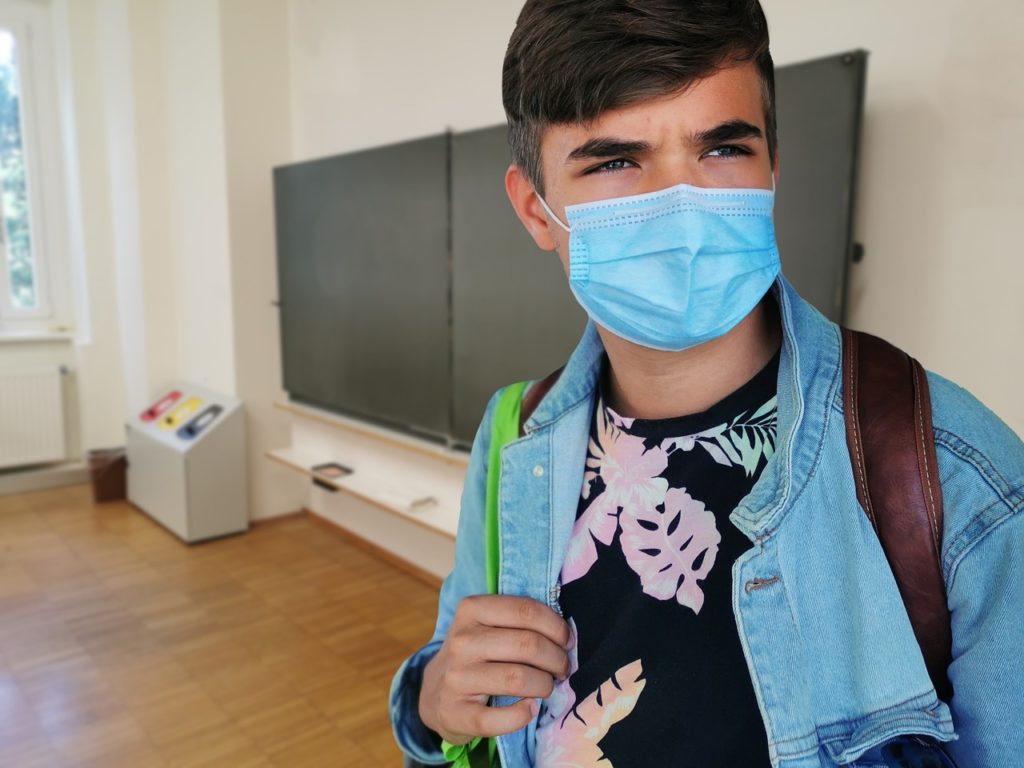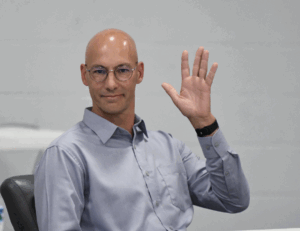
As COVID cases rise, School Board pauses on K-5 return
Increasing positive COVID tests, strains on the local healthcare system and concerns about logistics and staffing have resulted in another change to Wayne County Public Schools’ plan for K-5 students.
The district reversed course and will stay in Plan B at least until the end of the first quarter of the spring semester, Board of Education members decided by a narrow vote during a special-called meeting Wednesday.
The 4-3 decision came on the heels of presentations by Central Office staff about the challenges the district faces in the wake of the COVID-19 pandemic, and a recommendation by interim superintendent Dr. David Lewis to delay returning to Plan A for the district’s kindergarten through fifth-graders.
Wednesday was not the first time the board explored a Plan A return for elementary school students.
In fact, Central Office staff have been reviewing the potential concerns, costs and challenges at the direction of the board for more than two months, as a majority of board members have leaned toward getting students back in the classroom, citing education and emotional challenges.
However, after hearing the statistics and findings from a staff survey and the Health Department, board members Len Henderson, Patricia Burden and Tommy Sanders, along with board chairman Chris West, voted to remain in Plan B.
Board members Jennifer Strickland and Wade Leatham, along with vice chairman Dr. Joe Democko, voted against the measure.
Lewis said that the concerns about the increasing coronavirus infection numbers in Wayne County, which is designated “orange” under the state’s measurement system, and strain on the health system are the reasons for his recommendation to stay with Plan B.
“Every metric that they track is going up,” he told the board.
Lewis said the increase was expected in the wake of the holiday season but is still concerning.
“The worry moving forward for me is the information I am getting from the hospital,” he said.
Lewis said hospital officials are reporting that the number of new cases is outpacing recovery numbers, putting a strain on personnel and care, forcing Wayne UNC to pull some of its nurses from its joint agreement with the county schools.
The problem is that no one knows the course the disease will take, Lewis said.
“Anyone who is trying to make accurate predictions about this stuff … you can’t do it,” he said.
He added that health officials are predicting the virus will peak in late January or early February.
“It stands to reason that the community spread will affect the schools as well,” Lewis said.
There is currently a waiting list for the first rounds of the vaccine, which are designated for direct contact health care workers and people over the age of 75, local health officials say.
Teachers over age 50 are next on the list to sign up for the vaccine (Jan. 20) as well as other essential workers as designated by the Federal government.
But they will not get their doses until the backup on the first round has been met.
Lewis said that because of the unknowns and the concerns, waiting a bit longer would be the best course for the district.
“We have proven we can operate under Plan B without contributing to the community spread,” he said.
He added that if the district moved to Plan A, which does not require or allow for social distancing, and school infections rose, the district would make the community infection rate worse.
Lewis said making a decision about the next steps should be done swiftly, adding that his staff has worked hard “to do their best to do what you have asked them to do.”
“All the things they can control, they will continue to do (masks, sanitation),” he said. Social distancing under a Plan A return, however, is the wild card.
Board members disagreed about the best course of action, with Leatham pointing out that some surrounding districts have made the choice to return to Plan A.
And Strickland maintained her position that students needed to get back to school and parents need a definitive decision from the board.
She added that colleges and universities are strongly considering moving back to face-to-face learning.
Strickland also pointed out that while the infection metrics might be increasing, the rate still represents a very small portion of the county’s population.
The schools, she said, could return safely.
“We have done this, and we have done it very, very well. We can do this,” she said.
She added that the district will continue to lose students to private and charter schools if it does not get the children back into the classroom.
Democko said that he doesn’t understand why other states like Florida and South Carolina have been able to return to face-to-face classes and North Carolina is still restricting attendance.
“I am wondering if we have a different strain of coronavirus in North Carolina,” he said. “How are they all going back to face to face? Here the sky is falling every single day.”
In the end, what matters is not what other states or districts are doing, but what is best for Wayne County, West said.
Before the vote, the board listened to reports from Central Office staff.
Ken Derksen, the district’s communications and public relations officer, presented the board with a survey of surrounding districts. Most of them have plans to reconsider a K-5 Plan A or K-12 Plan B return at the end of January, but currently have their students in remote instruction.
Johnston County, for instance, put its students into remote instruction through Jan. 19, with plans to return exceptional children and pre-kindergarten students to Plan A next week and K-12 to Plan B Jan. 19.
Wilson and Pitt counties have students in remote instruction and are planning to return to Plan A for K-5 and Plan B for 6-12 at the end of January.
Derksen said that the survey of districts is an evolving report, with boards looking at the same issues facing Wayne County, and adjusting policies accordingly.
“All of the districts are looking at the metrics,” he said.
And those numbers include the rate of infection in the community as well as staff available to cover shifts affected by mandatory quarantines and positive COVID tests.
Dr. Carol Artis, who is handling teaching and learning duties after the recent departure of Dr. Tamara Berman-Ishee, also shared the results of a staff survey, with 81 percent of elementary principals saying they feel remaining in Plan B is the best choice and 50 percent of them saying that most of their staff had concerns about the return under Plan A.
Among those concerns were the inability to social distance students under Plan A and the increased exposure risk for staff as well as the consequences of more quarantine and the resulting staff shortages.
Despite their concerns, however, Artis said school personnel are prepared to open under any plan.
“All of our principals do have a reasonable plan to return to Plan A,” she said.
Dr. Marcia Manning, assistant superintendent for student services and innovative programs, discussed concerns about keeping nurses in the county schools as there is increased need at the local hospital, straining resources and forcing long hours and shifts for those who serve both the district and Wayne UNC Health.
Manning said despite the challenges, she and the nursing staff have worked hard to make sure Wayne County put the needs of students and staff first while following state health rules and regulations.
“Our commitment to all of our families is that if you have been in direct contact with someone who has tested positive for COVID, you are personally notified,” Manning said.
Manning and Lewis said the district feels confident that it has maintained a safe environment for teachers and students under Plan B, citing the low number of positive cases at the schools as well as strict rules for sanitizing, testing and quarantining.
Both credited the hard work of the staffs at each school as the reason for the success.
Dr. Tim Harrell, assistant superintendent for support services, said the district is prepared to handle transportation and child nutrition services under a Plan A return, but acknowledged that a Plan B return could cause continued funding problems for child nutrition, which relies on student participation to handle its expenses.
While CARES act funds can be used to cover the loss of shifts for school bus drivers, allowing them to move to assisting with sanitizing the schools, child nutrition personnel would face lost wages and perhaps cuts if revenue goals are not met, Harrell said.
“(Child Nutrition) is like a restaurant. If you don’t serve enough, you can’t make the overhead,” he said.
Dr. Yvette Smith Mason, assistant superintendent for human resources, said there are also concerns about staffing.
Exposure and quarantine requirements and a greatly reduced WCPS substitute pool mean principals are struggling to make sure every class is covered.
The district has about 1,100 teachers, and a pool of 233 trained subs. Of that number, Mason said, only 130 said they will accept positions in the schools. This past week, only 96 actually responded to the staffing requests, leaving 11 absences uncovered and forcing staff to struggle to cover for each other.
Add to that the loss of the funding provided by the Families First Coronavirus Relief Act, which allowed employees to use designated paid COVID time off to deal with quarantines and the exposure or illness of family members, and the district is struggling to make sure employees do not exhaust their sick time trying to deal with coronavirus exposure or infection.
The decision not to renew the funding was made by the federal government and is an issue that is facing districts and governments all over the country, Mason said.
Wayne County is exploring options like teleworking as well as other funding options to make sure employees are covered.
“All of us across the state are looking at what our options are,” she said.
More relief might be in sight to help the district manage COVID-related expenses, new finance director Leslie Rouse said.
Rouse said she has been notified that the district can expect more CARES money soon, with a much larger award coming in a couple of weeks.
As with the last round of funding, there will be rules for its use, she said, but added that it will help the district deal with the budget constraints caused by the pandemic.

A loaded discussion

Fighting for their lives

Goldsboro loses a giant

“I’m a flippin’ hurricane!”
Public Notices — Dec. 14, 2025

Belting it out

Legendary

Final Four!


